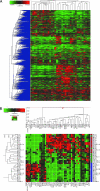Pharmacodynamic characterization of the efficacy signals due to selective BRAF inhibition with PLX4032 in malignant melanoma
- PMID: 20689758
- PMCID: PMC2915408
- DOI: 10.1593/neo.10414
Pharmacodynamic characterization of the efficacy signals due to selective BRAF inhibition with PLX4032 in malignant melanoma
Abstract
Purpose: About 65% to 70% of melanomas harbor a mutation in v-raf murine sarcoma viral oncogene homolog B1 (BRAF) that causes the steady-state activation of extracellular signal-regulated kinase (ERK). We sought to investigate the efficacy of PLX4032 (BRAF inhibitor) to identify patterns/predictors of response/resistance and to study the effects of BRAF in melanoma.
Experimental design: Well-characterized melanoma cell lines, including several with acquired drug resistance, were exposed to PLX4032. Growth inhibition, phosphosignaling, cell cycle, apoptosis, and gene expression analyses were performed before and after exposure to drug.
Results: Using a growth-adjusted inhibitory concentration of 50% cutoff of 1 microM, 13 of 35 cell lines were sensitive to PLX4032, 16 resistant, and 6 intermediate (37%, 46%, and 17% respectively). PLX4032 caused growth inhibition, G(0)/G(1) arrest, and restored apoptosis in the sensitive cell lines. A BRAF mutation predicted for but did not guarantee a response, whereas a neuroblastoma RAS viral oncogene homolog mutation or wild-type BRAF conferred resistance. Cells with concurrent BRAF mutations and melanocortin 1 receptor germ line variants and/or a more differentiated melanocyte genotype had a preferential response. Acquired PLX4032 resistance reestablishes ERK signaling, promotes a nonmelanocytic genotype, and is associated with an increase in the gene expression of certain metallothioneins and mediators of angiogenesis.
Conclusions: PLX4032 has robust activity in BRAF mutated melanoma. The preclinical use of this molecule identifies criteria for its proper clinical application, describes patterns of and reasons for response/resistance, and affords insight into the role of a BRAF mutation in melanoma.
Figures






Similar articles
-
Melanomas acquire resistance to B-RAF(V600E) inhibition by RTK or N-RAS upregulation.Nature. 2010 Dec 16;468(7326):973-7. doi: 10.1038/nature09626. Epub 2010 Nov 24. Nature. 2010. PMID: 21107323 Free PMC article.
-
Adaptive upregulation of FOXD3 and resistance to PLX4032/4720-induced cell death in mutant B-RAF melanoma cells.Oncogene. 2012 May 10;31(19):2471-9. doi: 10.1038/onc.2011.424. Epub 2011 Sep 26. Oncogene. 2012. PMID: 21996740 Free PMC article.
-
The BRAF(V600E) inhibitor, PLX4032, increases type I collagen synthesis in melanoma cells.Matrix Biol. 2015 Oct;48:66-77. doi: 10.1016/j.matbio.2015.05.007. Epub 2015 May 16. Matrix Biol. 2015. PMID: 25989506 Free PMC article.
-
BRAF as a target for cancer therapy.Anticancer Agents Med Chem. 2011 Mar;11(3):285-95. doi: 10.2174/187152011795347469. Anticancer Agents Med Chem. 2011. PMID: 21426297 Review.
-
Vemurafenib in patients with BRAF V600E mutation-positive advanced melanoma.Clin Ther. 2012 Jul;34(7):1474-86. doi: 10.1016/j.clinthera.2012.06.009. Epub 2012 Jun 27. Clin Ther. 2012. PMID: 22742884 Review.
Cited by
-
Melanoma brain colonization involves the emergence of a brain-adaptive phenotype.Oncoscience. 2014 Jan 10;1(1):82-94. doi: 10.18632/oncoscience.11. eCollection 2014. Oncoscience. 2014. PMID: 25593989 Free PMC article.
-
Acquired and intrinsic BRAF inhibitor resistance in BRAF V600E mutant melanoma.Biochem Pharmacol. 2011 Aug 1;82(3):201-9. doi: 10.1016/j.bcp.2011.05.015. Epub 2011 May 25. Biochem Pharmacol. 2011. PMID: 21635872 Free PMC article. Review.
-
WNT5A enhances resistance of melanoma cells to targeted BRAF inhibitors.J Clin Invest. 2014 Jul;124(7):2877-90. doi: 10.1172/JCI70156. Epub 2014 May 27. J Clin Invest. 2014. PMID: 24865425 Free PMC article.
-
The APC/C E3 Ligase Complex Activator FZR1 Restricts BRAF Oncogenic Function.Cancer Discov. 2017 Apr;7(4):424-441. doi: 10.1158/2159-8290.CD-16-0647. Epub 2017 Feb 7. Cancer Discov. 2017. PMID: 28174173 Free PMC article.
-
Overcoming intratumor heterogeneity of polygenic cancer drug resistance with improved biomarker integration.Neoplasia. 2012 Dec;14(12):1278-89. doi: 10.1593/neo.122096. Neoplasia. 2012. PMID: 23308059 Free PMC article.
References
-
- Curtin JA, Fridlyand J, Kageshita T, Patel HN, Busam KJ, Kutzner H, Cho KH, Aiba S, Brocker EB, LeBoit PE, et al. Distinct sets of genetic alterations in melanoma. N Engl J Med. 2005;353:2135–2147. - PubMed
-
- Curtin JA, Busam K, Pinkel D, Bastian BC. Somatic activation of KIT in distinct subtypes of melanoma. J Clin Oncol. 2006;24:4340–4346. - PubMed
-
- Landi MT, Bauer J, Pfeiffer RM, Elder DE, Hulley B, Minghetti P, Calista D, Kanetsky PA, Pinkel D, Bastian BC. MC1R germline variants confer risk for BRAF-mutant melanoma. Science. 2006;313:521–522. - PubMed
Publication types
MeSH terms
Substances
Grants and funding
LinkOut - more resources
Full Text Sources
Other Literature Sources
Medical
Research Materials
Miscellaneous
